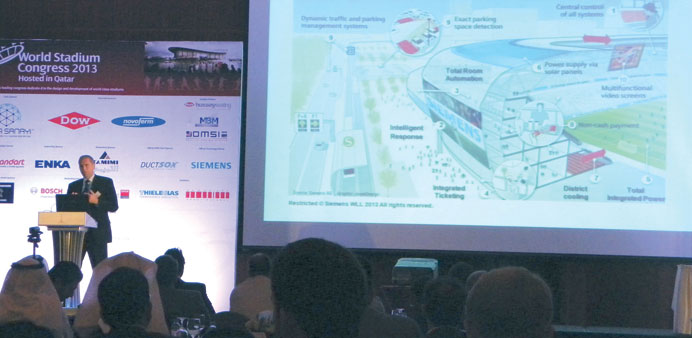
 By Joey Aguilar/Staff Reporter
By Joey Aguilar/Staff Reporter
Future designs of stadiums for high profile events are expected to be energy efficient, more secure and environment-friendly to meet the expectations of stakeholders and sports fans.
Jan Schoenig, programme manager of Qatar World Cup 2022-Siemens, said that trends in modern stadiums now focus on lowering operational costs, integrating energy –efficient features as part of “green goals”, and ensuring the comfort, security and safety of people.
“We have to focus for the future stadiums in Qatar and worldwide in creating all operations systems – fire, security, building management, and energy systems, having it really in one platform to reduce the operational cost,” he said.
Schoenig was one of the speakers during the World Stadium Congress which started yesterday at The Torch Doha. The three-day international conference has gathered top stadium experts, government officials from different countries and local organising committees.
He stressed the importance of an “integrated power supply”, a modern power distribution system which combines renewable energy and the use of fossil power generation as part of a modern eco-friendly grid.
This, he said, ensures reliable and efficient use of electrically-operated installations. It also compliments the use of large video walls without consuming too much electricity and meeting the audiences’ expectations.
“We want to make sure planners and designers of World Cup stadiums are aware of and take into account the possibilities of this modern power distribution system,” he said.
Citing the advantages of using these modern innovations, Schoenig said stadiums create a safe environment for spectators and at the same time reduce energy use and maintenance.
“On the infrastructure side, I would like to emphasise the security part which is a big part of fan experience if you feel secured in coming there,” he added.
One of the safety features of these modern stadiums is applying the “intelligence response concept”.
Once smoke is detected, dampers will automatically be activated, doors unlocked, and all spectators will be advised and guided safely.
Though the World Cup 2022 in Qatar is still nine years away, he noted that planners and architects have already been working on the layouts of the stadiums.
Siemens, a company involved in building more than 140 stadiums around the world, has also set up an office in Doha to help Qatar in various stadium preparations.
Asked about the capacity to cool stadiums, Schoenig said games can be played either in winter or summer.
“For the building it doesn’t matter, it is proven that you can cool the stadiums enough as promised where spectators are comfortable while watching the games. It is more about how you get there,” he added. “It is for the organisers to decide whether to keep it in winter or summer.”

Jan Schoenig of Siemens showing a model of a modern stadium during the World Stadium Congress. PICTURES: Joey Aguilar


